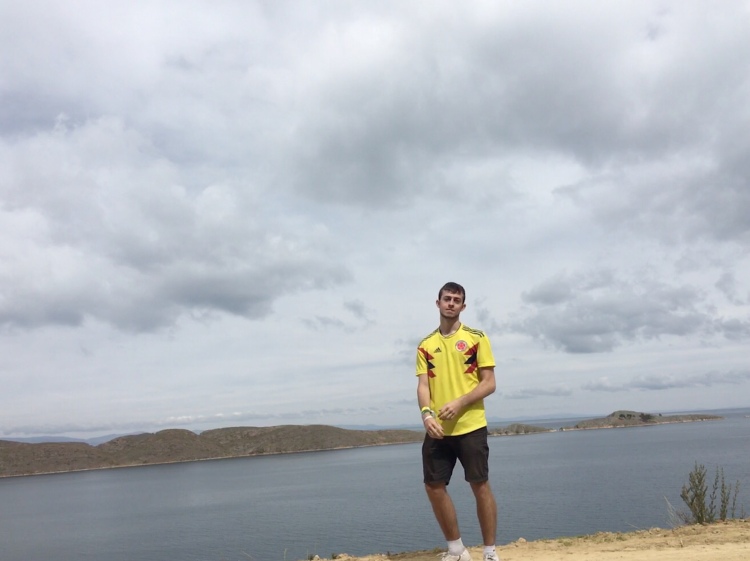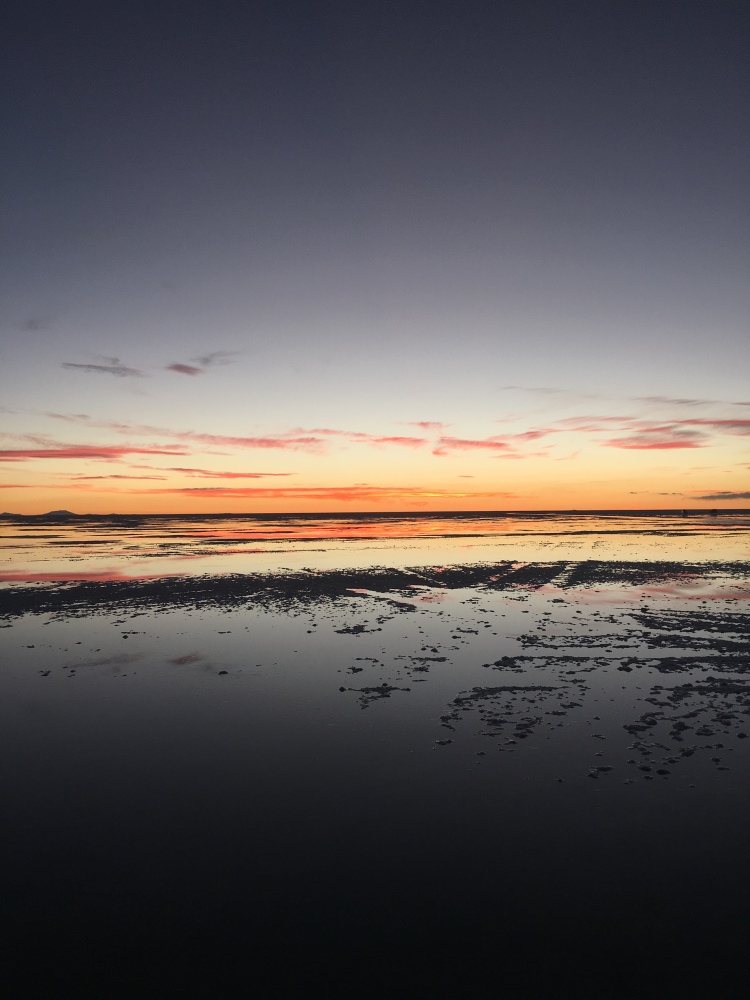I’m in South America. Coaching, playing, watching and writing about football. And seeing some other stuff, of course.
Every week, I’ll provide an update on what I’ve been doing, where I’ve gone and various other things. I’ve been writing online since I was 13, but still hate using personal pronouns like ‘I’, so this a bit of a new experience for me.
Hola a todos,
It’s April, and April in Bolivia is a synonym for rain. Thankfully, for the past four days, it has been beautifully dry. Now, as my bus traverses the road from Oruro to La Paz, a thunderstorm has brewed overhead and the occasional flash of lighting illuminates the otherwise dark top deck of the bus through steamed windows.
This journey is another long and arduous one, but it is off the back of one of the most amazing experiences I’ll ever have and the highlight of South America so far. After a few days in La Paz, Bolivia’s administrative capital, I travelled South for a four-day tour of the Salar de Uyuni and area surrounding Tupiza. It was a mixture of canyons, volcanoes, mountains, salt flats, enormous rock formations and intense sunrises, sunsets and night skies.
La Paz
I arrived in La Paz off the back of food poisoning but quickly recovered and enjoyed what is another of South America’s incessantly sprawling cities with equally evergreen traffic and colour.

On my first full day in the city, I ascended one of the many, many cable cars that climb up the mountain side. My destination was one of the world’s largest flea markets in the city of El Alto, now considered a separate entity from La Paz but without a noticeable border.
Overlooking the city, the market is a labyrinth of every possible item. My favourites, which I would have bought if I was a resident, were the second-hand fried chicken shop equipment and barber shop chair. But what I actually bought was a small bag and a lock, although the various fake/contraband designer coats were tempting.
Just about managing not to lose myself in the market, I made my way back down into La Paz for a city walking tour. Like all the walking tours I’ve done in South America so far, and previously in Europe, it was fantastic. There were some more markets on show, not quite as big but equally large in character, and plenty of new information of Bolivia politically as a country.
They currently have a President who was adored in his first two terms as the first indigenous man to fill the role, but is now attempting to install himself as a dictator by avoiding the rules of the constitution to seek a third term in office. His argument is that because he renamed the country in his first term (from the Republic of Bolivia to the Pluri-national state of Bolivia) and slightly altered the constituent, he has actually only been President of the current country for one term. He’s also said that eating too much chicken will turn you gay…
From a chicken fryer to gay chickens, it was an interesting first morning. In the evening I went to watch some football. Obviously. The people of Bolivia are not quite as friendly as in Colombia and the food is not quite as good, but the scenery and nature is on a whole new level.
Copacabana and Lake Titicaca
The next day, I woke up early for a 6AM bus to Lake Titicaca, the highest lake in the world at almost 4000m and the 18th largest in the world. Having seen it over two days, I’m astonished to know that there can possibly be any lake bigger.

On my first day in Copacabana, the most touristy town on the Bolivian side of Lake Titicaca (it stretches into Southern Peru), I took a boat to Isla del Sol, the place where the Incas believed that the Sun was born. The views were pretty amazing.

I returned to Copacabana in the evening, in time to watch the Sun set over the bay and I can now understand why, without any knowledge of science, the indigenous people of Bolivia would genuinely believe the Sun was born in this place.
After the Sun had gone down, I ate fresh trout in a small kiosk by the lake for £3.
On Saturday morning, I jumped into a small micro taxi which waits on a corner of a street until its full before heading to its destination. The place in question was Yampupata, a small fishing village on the tip of the island where Copacabana is. Sitting with a group of plump Bolivian ladies in traditional dress, I felt slightly out of place and was the only person left on the bus when we arrived at Yampupata.


The views off the bus were pretty good, but they were even better when I got off and walked the 18km or so back to Copacabana in time for lunch in a tiny indoor market where once again, I was stared at closely for being white.
I got a bus back to La Paz that evening, watching a film en route, and went out to taste the Bolivian nightlife, although I spent most of the time with a group of Germans, Dutch and Irish.
Tupiza
Having woken up at 11AM, I realised I had an hour to get out of bed and check out of my hostel as well as planning the next two weeks of my life. So, in between sips of water, I decided to head south straight away so that my schedule would allow me to watch the second leg of Manchester United against Barcelona.

At 3PM, I got on a bus to Tupiza, the town where Butch Cassidy and the Sundance Kid was filmed. I arrived at 4:30AM and sat in a (literally) freezing tiny bus terminal for a couple of hours, passing the time by briefly talking to an Bolivian man who was floating happily as chewed away at his coca leaves.
When the clock hit 7AM and the sun had risen, I walked over to a tour office in Tupiza and paid for a four-day tour of the Salar de Uyuni. Most people do a three-day tour from the town of Uyuni itself, but thankfully I had been advised to go to Tupiza for a tour which included more, was better quality and saw things at quieter times to the Uyuni crowd. It was the perfect advice.
We set off in a 4×4 Land Cruiser at 7:30AM and at 8AM I had my last bit of phone signal for four days, one of which would see United host Barcelona in the Champions League. I wouldn’t be able to watch the game in the middle of the desert, but, although painful, it was a worthwhile sacrifice.


With a group of four others plus the driver, the amount we did on each day was ridiculous. We’d wake at 7AM on the first three days and drive 300km over the course of 12 hours or so, stopping to see enormous rock formations, lakes tinted red with salmon-coloured flamingos poised in the sun kissed water, volcanoes spewing white smoke or to climb rocks or old rusting British trains from the 1850s.


The sheer variety of nature in one location was ridiculous. Every stop was worth a hundred photos, and we all took nearly that many each time. Every sky at night was free of light from below and so the milky way stretched right across the blackness.


On the final day, we left our accommodation at 5AM to watch the sun rise above the salt flats themselves. We had only arrived the evening before to watch sunset, which was spectacular with the redness reflected in the thin layer of water that covers the salt.



Sunrise was just as good, though my eyes were a little weary having also walked a mile or so to the salt flats the previous night with a couple of others from my group to see the stars and moon reflected, stretching from horizon to horizon.



But Thursday was the day for the salt flats, with sunrise, then a small stop for breakfast before finding an area without the thin water layer. The areas with just the salt allow you to take pictures that distort normal perspective. Not only that, but the sheer size of it is breathtaking. It’s 12,000km squared overall and contains more than 50% of the world’s salt. It’s also near impossible to convince yourself that it is salt and not snow. You can pick it up, make it into a ball and it crunches underneath your feet, and yet, when you have a small lick of your finger, you recoil because it is indeed salt.
Back to La Paz
After finishing the tour in Uyuni and saying goodbye to the good group and driver I had, I hopped on a bus to Oruro, another small mining town that used to be exploited by the British and others. There, I changed for a bus to La Paz and now I’m halfway there.
After one night in La Paz, I’ll head north to Rurrenabaque, the town next to the Amazon Rainforest. And there it’ll be time for another few days of isolation though instead of freezing morning and evening temperatures at an altitude of 5000m, it’ll be the humidity of the Amazon. And after, I’ll go back to La Paz to watch United secure another memorable comeback at the Nou Camp. Possibly.
Wow amazing pics Harry looks like you are having a ball, am really jealous of the travelling and very pleased that you have got over the food poisoning episode!!! Really enjoying your writing can’t think where you inherited that skill from!! Keep safe, have fun xxx
LikeLike